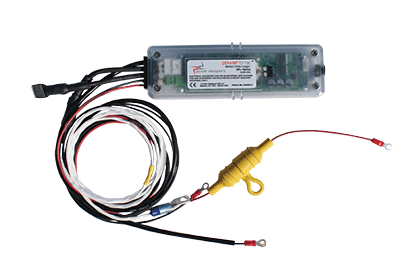PowerTrac SP+
The PowerTrac SP+ Series is a battery monitoring system developed specifically to meet the needs of industrial and motive battery systems. Using your battery while it is undercharged, low on water or operated at high temperatures could shorten the life of your battery, cause equipment malfunctions and negatively affect performance and productivity. The PowerTrac SP+ is a compact electronic device that attaches to your battery to provide you with instant battery diagnostics. The PowerTrac SP+ continuously acquires battery parameters, processes information and stores relevant data when an event change occurs. The battery monitor tracks and logs various battery performance data including battery voltage, battery temperature, and battery current. A conventional current shunt is used to provide precise battery current sensing.
Logs critical battery performance data, including:
- Instantaneous battery voltage, battery current, and temperature
- Charge and discharge Amp-Hours since installation and per event
- Charge and discharge events:
- Event type (charge/discharge)
- Event start time and duration
- Minimum and maximum voltages with time stamps
- Maximum current and temperature with time stamps
- Event Amp-Hours of charge/discharge
- Event end voltage (30 second average)
- Over/under voltage, over current, and over temperature alarms
Applications
- Forklift trucks
- Ground support equipment (GSEs)
- Neighborhood electric vehicles
Features
- Oversee and schedule maintenance operations and predict battery replacements
- Can be used with any type of battery
- Tracks battery performance over its entire life
- Program to track individual battery performance as well as entire fleet performance

FAQ
What does a PowerTrac do?
Can I use PowerTrac with any type battery?
Yes! The PowerTrac can go on any type of battery with nominal voltage ranging from 12 to 84 volts. This includes motive, automotive, and stationary batteries used in applications such as forklift trucks, walkies, floor scrubbers, golf carts, go karts, cellular sites, solar systems, telephone central offices, etc… The possibilities are endless.
Is a shunt required for PowerTrac to operate?
Yes. Since battery current, and in return amp-hours used and returned, are very critical to gauging battery utilization, measuring the battery current is a must. PowerTrac uses a shunt that can be installed within the battery or in line with the negative battery cable to measure the current in and out of the battery.
What type of shunts can be used?
The PowerTrac unit is designed to operate with a 50mV shunt of any size. The PowerTrac setup utilities allow users to set the shunt size for accurate current measurement.
What type of shunts are available?
There are two type of shunts that are offered, both being 500A/50mV type:
- Bolt-On shunt (Part No. PTBS-500): which is used with bolt-on battery terminals (mainly sealed type)
- Clamp-On shunt (Part No. PTCS-500): which is used with welded battery terminals (mainly flooded type)
Where would I install a shunt on the battery?
- If you are installing the shunt on an industrial battery with 2V cells, the shunt should installed in place of the last intercell connector (the shunt potential shouldn’t be more than 2V above he negative battery terminal). As for the PowerTrac shunt sense leads, the black lead of the twisted pair wire should be connected to the shunt terminal closest to the negative battery post.
- If you are installing the shunt on a battery string consisting of 6V or 12V series connected modules, the shunt should be placed in line with the negative battery cable. As for the PowerTrac shunt sense leads, the red lead of the twisted pair wire should be connected to the shunt terminal closest to the negative battery post
Are there special guidelines when installing a clamp-on shunt?
Yes. When installing a clamp-on shunt, care needs to be taken to avoid having a cold solder connection. For proper clamp-on shunt installation, do the following:
- Using the correct drill, remove the inter-cell connector nearest to the negative post leaving post’ centers.
- Clean post and area around the base of the posts.
- Place corrosion preventive felt washers around posts (May need to wet the felt washers).
- Position the shunt, centered over posts.
- Tighten the (2) ¼-20×2” shunt clamp screws securely onto the battery posts. Do not over-torque.
- Solder the shunt using a lead/solder stick alloy. Make sure to top fill the shunt post holes with lead/solder.
Note: To ensure good connection between the shunt posts and the battery posts, make sure that you apply direct heat to the shunt terminals and fill in the solder/lead bar into the shunt terminal holes until it fills completely.
CAUTION: Do not just melt the solder/lead bar into the shunt terminal holes without heating the shunt terminals. Soldering should be done via the heating action of the shunt terminals.
What to do when the battery has more than one post (more than one intercell connector)?
When installing a shunt on a large capacity battery with more than one-intercell connector, the shunt will replace only one of the intercell connectors. In order to compensate for uneven current division between the shunt and the remaining intercell connectors, use the shunt calibration tool provided in the Palm software.
